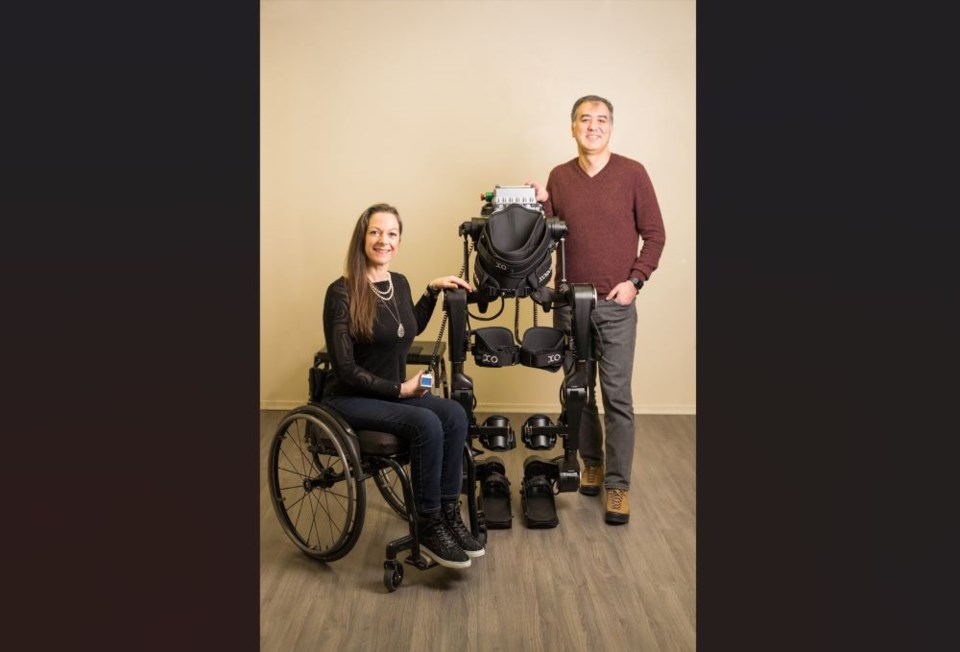As Chloë Angus stood up and walked over to receive the 2022 Courage to Come Back Award, she wore the very technology she’s being honoured for advocating and helping to advance: an exoskeleton.
It was an emotional experience for Angus, because it was not long ago she was told by multiple medical experts that she would never walk again.
In 2015, Angus was 40 years old and working long hours as a fashion designer. She’s originally from the Egmont area of the Sunshine Coast, near where her family has owned an organic seafood farm on Jervis Inlet for decades. Life then included walking the runway and red carpet. When she began feeling soreness in her back, she figured it was nerve pain. She went to the hospital when a tingling sensation spread from her toes up her leg. An MRI revealed a benign but inoperable tumour was growing in Angus’s spinal cord, and paralyzed her from the waist down within hours of her admission.
Now, Angus is being celebrated as a recipient of the 2022 Courage to Come Back Award in the medical category for her advocacy for people with immobility issues, and her support and collaboration with developing an exoskeleton.
“I can summarize the whole 5 years [of collaboration on the exoskeleton] in one sentence: without Chloë, we wouldn’t be where we are,” Dr. Siamak Arzanpour said in a press release about Angus’s award.
Arzanpour is an associate professor of the School of Mechatronic Systems Engineering at Simon Fraser University. He and Dr. Edward Park have been developing the robotic exoskeleton to perform much like the human body does, but with motorized hip, knee and ankle joints.
When Angus was told she’d never walk again, she was faced with the secondary health issues that come with a seated life — muscular atrophy, bone density loss, bowel and bladder problems — that would have her “steadily decline” for the rest of her life. The diagnosis also came with a treatment plan she didn’t agree with. Angus didn’t want to rely on opiods for pain management and began looking for other options to keep herself moving and ward off complications. That’s how she first heard of exoskeletons, a developing technology that people wear outside their body to move for them. But the technology was and is mostly limited to clinical research and rehabilitation, and within a few sessions of trying one, Angus realized it needs to be advanced for daily use. She reached out to researchers and found the team in Surrey.
“In this day and age, we have incredible technology — self-driving cars, drones that deliver medication, and we had man walk on the moon 50 years ago — but we still don't have a little lady like me being able to walk on Earth after a spinal cord injury,” Angus said.
“I was amazed that I searched the world for this technology, and I found it in my own backyard,” she said of the SFU team. She pointed out that B.C. has a growing reputation for success in robotics. “Canada's known for building the robotic arm, and now we're going to be known for building robotic legs, too.”
Angus became a founding member of the design and development team for Arzanpour and Park’s Human in Motion Robotics to help provide a user’s perspective. The technology they’re working on, Angus says, is crucial to regaining independence. It has independent balance and doesn’t require the use of a walker or nearby caretaker, it can go up and down stairs, and provide a full range of motion controlled by the wearer.
“When the team developed the exoskeleton, they took that approach in that they tried to mimic the human body instead of fitting the human body into a robot,” she said. “The future is here, where we will see these devices walking down streets.”
The benefits, Angus says, will be both physical, emotional and mental health.
“The absolute joy that I felt standing up and walking again for the first time, it's just made me so happy,” Angus said. “And it also gave me a little bit to push back and say that the statement, ‘You'll never walk again’ from anybody is no longer true. Because we have the technology today that can get people up and moving and walking again.”
First, the device will be available through clinics, then the goal is to be marketed for personal use. Last October, Angus demonstrated the exoskeleton at a tech trade show in Dubai. Human in Motion Robotics is currently in the middle of a financing round and looking for legacy investors, she said. Angus invited people to get in touch at [email protected].
To Angus, the award is a symbol of recognition of her “ability to survive … and thrive, and the effort that has gone into that.
“My story, I hope, gives people a little bit of strength to persevere and give them the hope that whatever challenges they're facing, that they might be able to make something better of it.”


.jpg;w=120;h=80;mode=crop)
